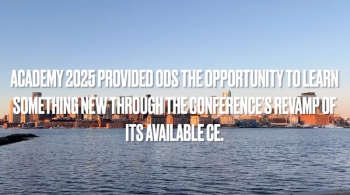
VEW 2022: Analyzing corneal diagnostics A-Z
John D. Gelles, OD, FAAO, FIAOMC, FCLSA, FSLS, FBCLA, shares highlights from his Vision Expo West presentation: "Corneal diagnostics: A-Z."
John D. Gelles, OD, FAAO, FIAOMC, FCLSA, FSLS, FBCLA, director of the Specialty Contact Lens Division of the Cornea and Laser Eye Institute - CLEI Center for Keratoconus in Teaneck, New Jersey, speaks with Optometry Times®' Alex Delaney-Gesing on highlights from his discussion titled, "Corneal diagnostics: A-Z," presented at the 2022 Vision Expo West meeting in Las Vegas, Nevada.
Editor's note: The transcription below has been lightly edited for clarity.
Could you share a highlights version of your presentation?
So corneal diagnostics is going to cover pretty much everything that you would use to diagnose and manage virtually any corneal disease that you're going to run into. Whether it's surface-related, such as dry eye, or if it's shape-related, such as keratoconus or ectasia, or it’s endothelial conditions, such as Fuchs’ [dystrophy] … basically this is going to cover all of the various diagnostic instruments that you would use to be able to find these diseases and how to monitor them, and then at what stage you may refer a patient out for a treat.
Why is this such an important topic of discussion?
It’s pretty important because you have multiple hot topics in optometry that have come up. And in general, we may not be as familiar with using corneal diagnostics as we are with using posterior segment diagnostics. We're all very familiar with posterior segment OCT and the way that that works for glaucoma and macular degeneration, but we may be quite a bit less familiar with its use in diagnostics of corneal diseases. We can use corneal OCT, for instance, to find the earliest signs of keratoconus, where we can look at the thickness and distribution of the epithelium on a cornea to diagnose it. So knowing those little nuances of the tools and what's available … and some of the things that I'm going to talk about, a lot of us are going to have those in our practices. And we may not have even been aware that they have the ability to do these corneal diagnostics, so it should be pretty eye opening.
What are the key takeaways you'd like attendees to learn in your presentation?
Mostly, that corneal diagnostics are very important. We have a lot of different things that are coming up, whether it's myopia management and, thus, our need to understand the corneal topography and corneal tomography—the management of keratoconus has changed. So we need to understand the metrics of change; various different tools and instruments are very new to us. And certain things have new treatments—such as the use of growth factor for treating neurotrophic corneas. Understanding what sort of testing for finding a neurotrophic cornea is important as well. So all of these are going to be very important for us to understand what we're doing so we can provide the best care for our patients.
Newsletter
Want more insights like this? Subscribe to Optometry Times and get clinical pearls and practice tips delivered straight to your inbox.













































.png)


